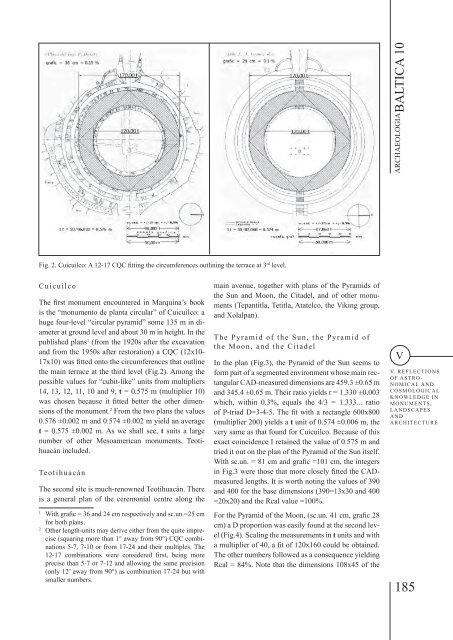BALTICA10
BALTICA10
BALTICA10
Create successful ePaper yourself
Turn your PDF publications into a flip-book with our unique Google optimized e-Paper software.
ARCHAEOLOGIA BALTICA 10<br />
Fig. 2. Cuicuilco: A 12-17 CQC fitting the circumferences outlining the terrace at 3 rd level.<br />
Cuicuilco<br />
The first monument encountered in Marquina’s book<br />
is the “monumento de planta circular” of Cuicuilco: a<br />
huge four-level “circular pyramid” some 135 m in diameter<br />
at ground level and about 30 m in height. In the<br />
published plans 1 (from the 1920s after the excavation<br />
and from the 1950s after restoration) a CQC (12x10-<br />
17x10) was fitted onto the circumferences that outline<br />
the main terrace at the third level (Fig.2). Among the<br />
possible values for “cubit-like” units from multipliers<br />
14, 13, 12, 11, 10 and 9, t = 0.575 m (multiplier 10)<br />
was chosen because it fitted better the other dimensions<br />
of the monument. 2 From the two plans the values<br />
0.576 ±0.002 m and 0.574 ±0.002 m yield an average<br />
t = 0.575 ±0.002 m. As we shall see, t suits a large<br />
number of other Mesoamerican monuments, Teotihuacán<br />
included.<br />
Teotihuacán<br />
The second site is much-renowned Teotihuacán. There<br />
is a general plan of the ceremonial centre along the<br />
1<br />
With grafic = 36 and 24 cm respectively and sc.un.=25 cm<br />
for both plans.<br />
2<br />
Other length-units may derive either from the quite imprecise<br />
(squaring more than 1° away from 90°) CQC combinations<br />
5-7, 7-10 or from 17-24 and their multiples. The<br />
12-17 combinations were considered first, being more<br />
precise than 5-7 or 7-12 and allowing the same precision<br />
(only 12’ away from 90°) as combination 17-24 but with<br />
smaller numbers.<br />
main avenue, together with plans of the Pyramids of<br />
the Sun and Moon, the Citadel, and of other monuments<br />
(Tepantitla, Tetitla, Atatelco, the Viking group,<br />
and Xolalpan).<br />
The Pyramid of the Sun, the Pyramid of<br />
the Moon, and the Citadel<br />
In the plan (Fig.3), the Pyramid of the Sun seems to<br />
form part of a segmented environment whose main rectangular<br />
CAD-measured dimensions are 459.3 ±0.65 m<br />
and 345.4 ±0.65 m. Their ratio yields r = 1.330 ±0.003<br />
which, within 0.3%, equals the 4/3 = 1.333... ratio<br />
of P-triad D=3-4-5. The fit with a rectangle 600x800<br />
(multiplier 200) yields a t unit of 0.574 ±0.006 m, the<br />
very same as that found for Cuicuilco. Because of this<br />
exact coincidence I retained the value of 0.575 m and<br />
tried it out on the plan of the Pyramid of the Sun itself.<br />
With sc.un. = 81 cm and grafic =101 cm, the integers<br />
in Fig.3 were those that more closely fitted the CADmeasured<br />
lengths. It is worth noting the values of 390<br />
and 400 for the base dimensions (390=13x30 and 400<br />
=20x20) and the Rcal value =100%.<br />
For the Pyramid of the Moon, (sc.un. 41 cm, grafic 28<br />
cm) a D proportion was easily found at the second level<br />
(Fig.4). Scaling the measurements in t units and with<br />
a multiplier of 40, a fit of 120x160 could be obtained.<br />
The other numbers followed as a consequence yielding<br />
Rcal = 84%. Note that the dimensions 108x45 of the<br />
V<br />
V. REFLECTIONS<br />
OF ASTRO-<br />
NOMICAL AND<br />
COSMOLOGICAL<br />
KNOWLEDGE IN<br />
MONUMENTS,<br />
LANDSCAPES<br />
AND<br />
ARCHITECTURE<br />
185
















